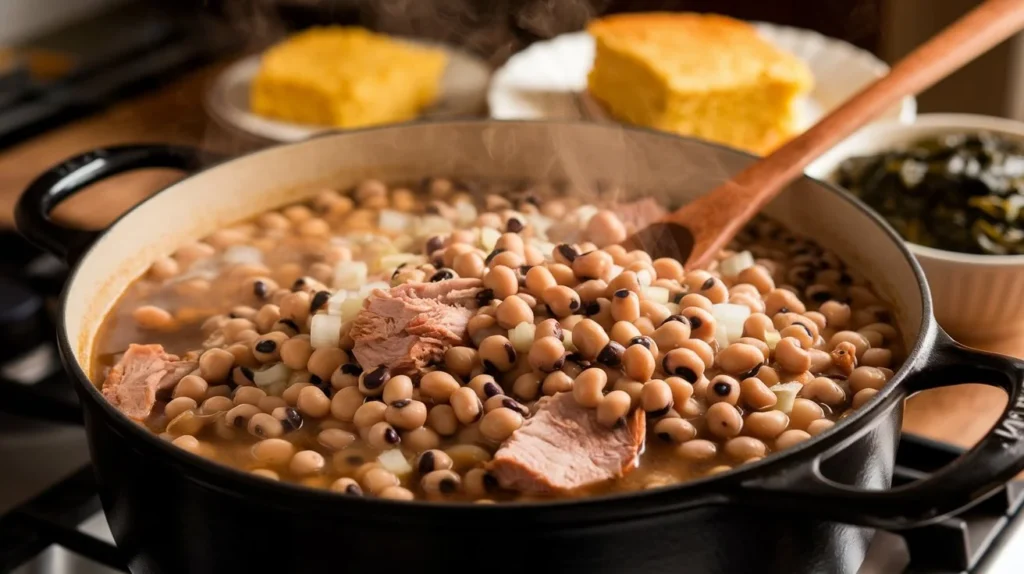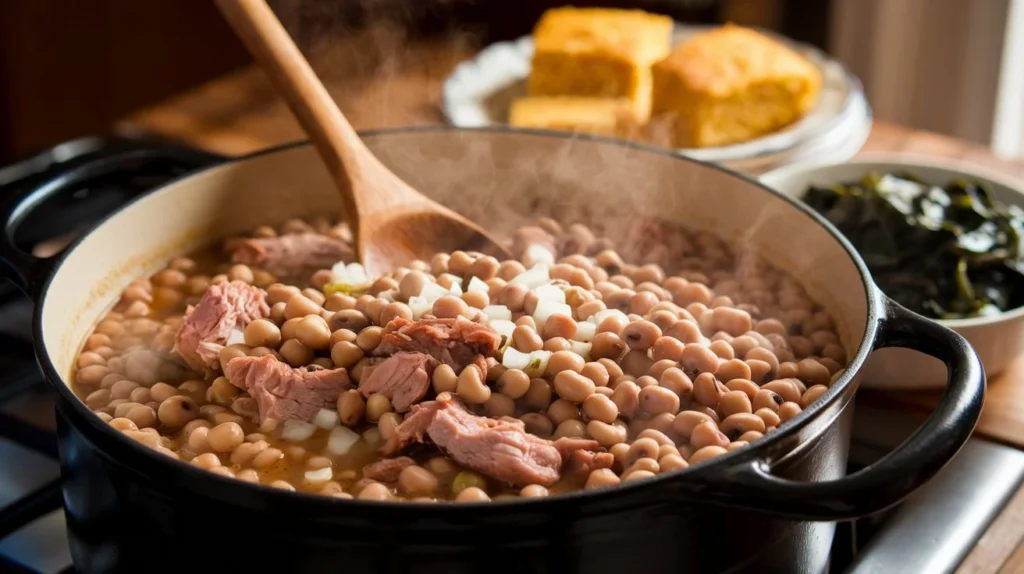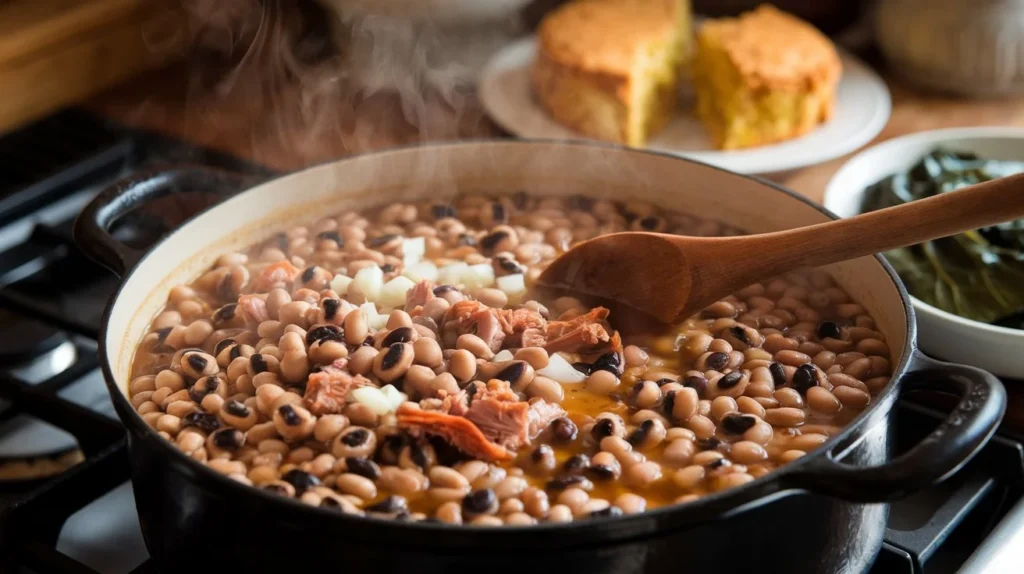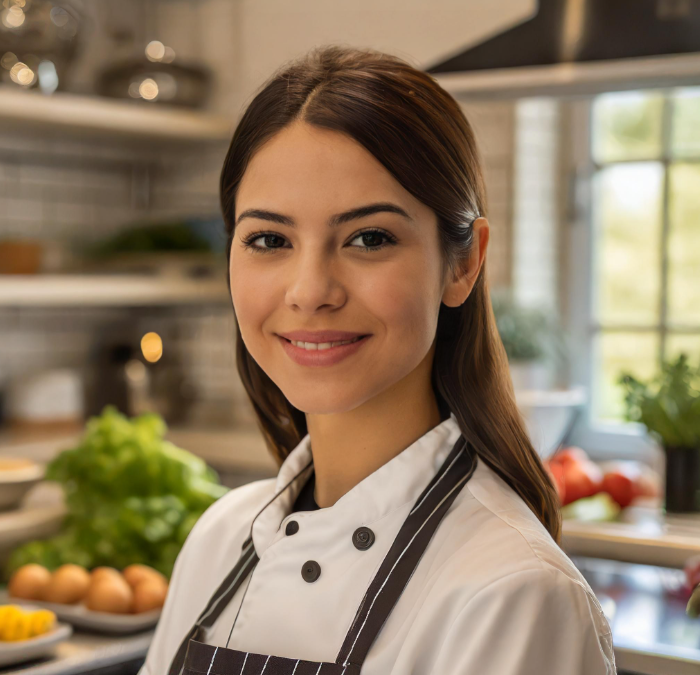Southern Black-Eyed Peas Recipe: A Flavorful Southern Classic
Southern black-eyed peas aren’t just a tasty dish — they’re a symbol of prosperity and comfort deeply rooted in Southern tradition. This Southern Black-Eyed Peas Recipe offers a rich, hearty flavor perfect for family meals, holidays, and cozy gatherings. With tender black-eyed peas simmered to perfection alongside smoky meats and aromatic spices, it’s the ultimate comfort food.
This guide walks you through every step of creating the perfect pot of Southern black-eyed peas, from choosing the best peas to serving them with classic sides like cornbread. Whether you’re cooking for a holiday or just craving a soulful dish, this recipe delivers authentic Southern goodness.
Introduction to Southern Black Eyed Peas
What Are Black-Eyed Peas?
Black-eyed peas are a type of legume with a distinct cream color and a small black spot on one side. Originating in West Africa, these peas became a staple in Southern cuisine, celebrated for their earthy, nutty flavor and soft texture when cooked.
They’re incredibly versatile and can be enjoyed in stews, salads, or as a main dish. Plus, they pack a nutritional punch, offering a great source of protein, fiber, folate, and iron.
Cultural Significance in Southern Cuisine
Black-eyed peas have a rich history, especially in the American South. Traditionally, they’re served on New Year’s Day, symbolizing good luck and prosperity for the year ahead.
This practice dates back to the Civil War when the peas, once considered food for livestock, were embraced as a survival food. Today, they remain a cherished part of Southern heritage, often paired with collard greens, cornbread, and smoked meats for a complete, symbolic meal.
Overview of the Southern Black Eyed Peas
This Southern black-eyed peas recipe is all about rich flavors and heartwarming comfort. The peas simmer with a medley of spices, aromatics, and smoked meat, creating a deep, savory broth.
Perfect for holidays or everyday meals, the dish pairs wonderfully with cornbread and greens, making it a wholesome, comforting choice for any occasion. Stay tuned for the next section, where we’ll cover the essential ingredients and preparation tips!
Ingredients and Preparation

Crafting the perfect Southern Black-Eyed Peas Recipe starts with selecting quality ingredients and proper preparation techniques. The ingredients you choose can make or break the depth of flavor, while the right prep ensures tender, perfectly cooked peas. Let’s break it all down step by step.
Selecting Quality Black-Eyed Peas
Not all black-eyed peas are created equal! The quality of your peas directly affects the texture and taste of your dish.
Dried vs. Canned Black-Eyed Peas
- Dried black-eyed peas are the preferred choice for this classic recipe due to their firmer texture and richer, nuttier flavor when properly cooked.
- Canned black-eyed peas, on the other hand, offer convenience but often lack the same depth of flavor and can turn mushy if overcooked.
Tips for Choosing the Best Black-Eyed Peas
- Look for dried peas that are uniform in size, free from debris, and without cracks.
- Avoid old stock, as aged peas may take longer to cook and can result in uneven tenderness.
- If using canned peas, choose low-sodium options and rinse thoroughly to remove excess salt and preservatives.
Essential Ingredients for Southern Black Eyed Peas
A traditional Southern black-eyed peas recipe relies on a simple yet effective blend of ingredients to build rich, comforting flavors.
List of Core Ingredients:
- Black-eyed peas – The star of the dish, providing a creamy texture with a mild, earthy taste.
- Smoked meat (ham hocks, smoked turkey) – Adds depth, smokiness, and saltiness to the broth.
- Onion, garlic, and celery – The aromatic base, enhancing the overall flavor.
- Chicken broth or water – For simmering and creating a rich, flavorful cooking liquid.
- Seasonings:
- Salt and black pepper for basic seasoning
- Bay leaves for herbal notes
- Paprika and cayenne for mild heat (optional)
Role of Each Ingredient in Flavor Development:
- Black-eyed peas absorb the flavors of the broth, making them the ideal base for this dish.
- Smoked meat provides umami richness and a savory, slightly salty note.
- Aromatics like onion and garlic create a strong flavor foundation.
- Chicken broth intensifies the overall taste more than plain water.
- Seasonings balance the dish, adding complexity without overpowering the peas’ natural flavor.
Preparation Steps for Southern Black-Eyed Peas Recipe
Proper preparation ensures the peas cook evenly and develop a rich, well-balanced flavor.
Soaking Methods for Dried Peas
Soaking dried black-eyed peas before cooking helps soften the peas, shorten the cooking time, and improve their texture.
- Overnight Soak: Place the peas in a large bowl, cover them with water (at least 3 inches above the peas), and let them soak for 8-12 hours.
- Quick Soak Method: If you’re short on time, bring the peas to a boil in a pot of water, remove from heat, cover, and let them sit for 1 hour.
Importance of Soaking:
- Reduces cooking time significantly.
- Helps the peas cook evenly.
- Minimizes the risk of digestive issues caused by complex sugars.
Using Baking Soda in Preparation
Baking soda is a secret trick used in many Southern kitchens to achieve tender black-eyed peas.
Traditional Southern Technique:
Adding a small pinch of baking soda during the soaking or cooking process can help break down the tough outer skins of the peas, making them tender faster.
Benefits of Baking Soda:
- Speeds up the cooking process by softening the peas.
- Reduces the gas-producing compounds found in legumes.
Appropriate Quantity and Precautions:
- Use only 1/4 teaspoon per pound of dried black-eyed peas.
- Avoid overusing baking soda, as it can cause a soapy taste and overly mushy peas.
Proper ingredient selection and preparation lay the foundation for a flavorful, satisfying pot of Southern black-eyed peas. Next, we’ll dive into the cooking process, where the magic truly happens!
Cooking Instructions for Southern Black-Eyed Peas Recipe
Now that your ingredients are prepped and the peas are soaked, it’s time to bring all those flavors together in a rich, hearty pot of Southern black-eyed peas. This part focuses on the step-by-step cooking process, ensuring every bite is infused with Southern comfort.
Sautéing Aromatics for Maximum Flavor
Aromatics are the foundation of this dish, laying the groundwork for a savory, well-rounded taste.
Importance of Onions, Garlic, and Celery
These three ingredients—often called the Holy Trinity in Southern cooking—are essential for depth and complexity:
- Onions: Sweet and slightly pungent, they provide a base of umami richness.
- Garlic: Adds warmth and a subtle sharpness.
- Celery: Offers a mild, earthy undertone that complements the legumes.
Techniques for Enhancing Flavor:
- Preheat the Pot: Start with a heavy-bottomed pot or Dutch oven over medium heat.
- Sauté in Oil: Use a neutral oil or rendered fat from smoked meat for added richness.
- Sweat the Aromatics: Cook the onions, garlic, and celery until softened but not browned, about 5 minutes.
- Layering Flavors: Add a pinch of salt during sautéing to draw out moisture and enhance the aroma.
Incorporating Smoked Meats for Authentic Southern Taste

Smoked meats are a key component in Southern black-eyed peas recipes, infusing the broth with bold, smoky goodness.
Options for Smoked Meats:
- Ham hocks: A Southern classic, known for their deep, salty, smoky flavor.
- Smoked turkey legs or wings: A healthier alternative with similar depth.
- Turkey sausage: A leaner option while still delivering smokiness.
Impact on the Dish’s Depth and Smokiness:
Smoked meats not only enhance the taste but also enrich the cooking liquid, transforming it into a flavorful broth. The rendered fat adds a velvety mouthfeel, while the smoky notes balance the earthy peas.
How to Incorporate Smoked Meat:
- Add the smoked meat directly after sautéing the aromatics.
- Allow it to sear slightly, releasing its juices and flavor.
- Deglaze the pot with a splash of broth to lift any caramelized bits from the bottom.
Simmering the Black-Eyed Peas to Perfection
Now that your aromatics and smoked meats are ready, it’s time to cook the peas until they’re tender and flavorful.
Optimal Liquid Ratios (Water vs. Broth):
The cooking liquid plays a major role in the final taste. Here’s how to get it right:
- Water: Simple and neutral but requires additional seasoning.
- Chicken or vegetable broth: Adds a rich base flavor without the need for much seasoning.
Ratio Tip: Use about 4 cups of liquid for every 1 cup of dried peas.
Seasoning with Herbs and Spices:
The magic lies in balancing the flavors of your seasoning:
- Salt and black pepper: The essentials for flavor balance.
- Bay leaves: Earthy and slightly floral, perfect for legumes.
- Cayenne pepper or paprika: For a touch of heat.
- Thyme or oregano: Herbs that complement the smoky notes.
Achieving the Desired Consistency:
- Simmer on low heat for 1 to 1.5 hours until the peas are tender but not mushy.
- Stir occasionally to prevent sticking but avoid excessive stirring, which can break the peas.
- The broth should reduce slightly, creating a rich, stew-like texture without being overly thick.
Adjusting Seasonings for Perfect Balance
Taste testing is crucial to ensure the perfect bowl of Southern black-eyed peas.
Balancing Salt, Pepper, and Heat:
- Start with a conservative amount of salt, especially if using smoked meats.
- Adjust heat with paprika, cayenne, or red pepper flakes.
- Black pepper adds a mild kick without overpowering the dish.
Customizing to Personal Taste Preferences:
- Prefer a bolder smoky flavor? Add a splash of liquid smoke.
- Want a milder version? Reduce the smoked meat and use turkey sausage instead.
- For extra creaminess, mash a few peas against the side of the pot before serving.
With the peas now simmered to perfection, it’s time to explore the best ways to serve and enjoy this comforting Southern classic in the next part!
Serving Suggestions and Variations
A hearty pot of Southern black-eyed peas isn’t just about the cooking—it’s also about how you serve and enjoy this comforting dish. From classic Southern pairings to modern twists, this section explores ways to enhance your dining experience while keeping true to tradition.
Traditional Accompaniments for Southern Black-Eyed Peas Recipe
Black-eyed peas shine even brighter when served with classic Southern sides that elevate the dish’s rich, smoky flavors.
Serving with Cornbread
Few pairings feel more Southern than black-eyed peas and cornbread. The slightly sweet, crumbly texture of cornbread perfectly complements the savory, creamy peas. The cornbread also works as a sponge, soaking up the flavorful broth.
- Tip: For a twist, try skillet cornbread with crispy edges or corn muffins for individual servings.
Pairing with Collard Greens
Collard greens are a staple alongside black-eyed peas, especially on New Year’s Day. Their slightly bitter notes balance the richness of the peas, while the greens also symbolize financial prosperity.
- Simmer collard greens with garlic, onions, and smoked turkey for a harmonious flavor match.
- Pro Tip: Serve everything together with hot sauce on the side for a tangy kick.
Modern Twists on the Classic Black-Eyed Peas Recipe
While the traditional recipe is a masterpiece on its own, experimenting with new variations can keep the dish fresh and exciting.
Vegetarian Adaptations
You don’t need meat to enjoy a rich, smoky pot of black-eyed peas. A vegetarian version can be just as flavorful with the right spices and broth.
- Substitute for Ham Hocks: Use vegetable broth and enhance smokiness with smoked paprika, liquid smoke, or fire-roasted tomatoes.
- Extra Vegetables: Add carrots, bell peppers, and mushrooms for depth and texture.
Incorporating Additional Vegetables or Grains
For a heartier, nutrition-packed twist, try adding:
- Sweet Potatoes: Cubed and simmered along with the peas.
- Okra: For a Southern gumbo-style variation.
- Brown Rice or Quinoa: Stirred in at the end for a complete protein-packed meal.
These variations not only add unique textures but also boost the nutritional profile of the dish.
Storing and Reheating Leftovers
Southern black-eyed peas taste even better the next day as the flavors continue to meld. Proper storage ensures you keep that deliciousness intact.
Best Practices for Refrigeration and Freezing:
- Refrigeration: Allow the peas to cool completely before transferring them to an airtight container. Store in the fridge for up to 4 days.
- Freezing: Freeze peas in freezer-safe containers or bags for up to 3 months. Be sure to leave room for liquid expansion.
Maintaining Flavor and Texture Upon Reheating:
- Reheating on the Stove: Warm peas over low heat, adding a splash of broth or water to loosen the consistency if needed.
- Microwave: Reheat in short intervals, stirring occasionally for even heat distribution.
- Avoid Overcooking: Reheating too long can break down the peas and turn them mushy.

Frequently Asked Questions About Southern Black-Eyed Peas Recipe
Here are answers to common questions, ensuring your peas turn out perfectly every time:
Can I use canned black-eyed peas instead of dried?
Yes, but adjust cooking times accordingly. Canned peas are pre-cooked and need only to be simmered for 15-20 minutes to absorb the flavors.
What can I substitute for ham hocks to make the dish vegetarian?
Use vegetable broth and add smoked paprika or liquid smoke to mimic the smoky richness without meat.
Is it necessary to soak dried black-eyed peas before cooking?
Soaking reduces cooking time and helps achieve a uniform texture. However, it’s not mandatory—unsoaked peas will take longer to cook.
How can I reduce the gas-inducing effects of black-eyed peas?
Soaking the peas and adding a small pinch of baking soda during cooking can help break down complex sugars that cause gas.
Can I cook black-eyed peas in a slow cooker?
Absolutely! Combine all ingredients in a slow cooker and cook on low for 6-8 hours or until the peas are tender.
What is the significance of eating black-eyed peas on New Year’s Day?
In Southern tradition, eating black-eyed peas on New Year’s Day symbolizes good luck and prosperity for the coming year. The peas represent coins, while greens like collards represent financial success.
Conclusion
Southern black-eyed peas are more than just a meal—they’re a celebration of culture, tradition, and community. Whether served on New Year’s Day for good luck or enjoyed as a comforting dish any time of the year, this Southern black-eyed peas recipe offers a rich, savory experience. From traditional sides like cornbread and collard greens to modern twists like vegetarian adaptations, the possibilities are endless.
So, grab your ingredients, follow these steps, and bring a taste of the South to your table. Happy cooking!








